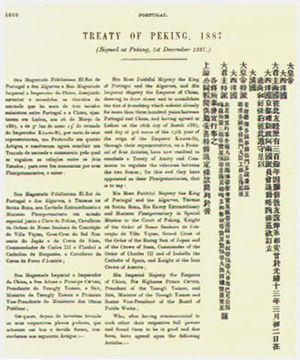Sino-Portuguese Treaty of Peking
| Treaty of Friendship and Commerce between Portugal and China | |
|---|---|
 | |
| Signed | 1 December 1887 |
| Location | Beijing (Peking), China |
| Effective | 28 April 1888 |
| Condition | Exchange of ratifications |
| Signatories |
|
| Parties | |
| Languages | Portuguese and Chinese |
| Sino-Portuguese Treaty of Peking | |
|---|---|
| Chinese name | |
Hanyu Pinyin | zhong1 pu2 li3 si4 ben3 cao3 yue1 |
| Yue: Cantonese | |
| Jyutping | zung1 pou1 lei5 si1 bun2 cou2 joek3 |
| This article is part of a series on the |
| History of Macau |
|---|
 |
| Other Macau topics |
| History of China |
The Sino-Portuguese Treaty of Peking was a trade unequal treaty between the Kingdom of Portugal and the Qing dynasty of China, signed on 1 December 1887. It is counted by the Chinese as among the unequal treaties in the aftermath of the Second Opium War. The treaty gave Portugal perpetual colonial rights to Macau on the condition that Portugal would cooperate in efforts to end the smuggling of opium.
Background
On 13 August 1862, China and Portugal signed the Treaty of Friendship and Trade in Tianjin. The treaty was largely a trade agreement, but it also defined Macau's political and juridical status, although it did not directly mention the issue of Portuguese sovereignty.[1] It contained two clauses regarding Macau's status: Article II annulled earlier agreements and referred to Macau as "formerly in the Province of Canton", while Article III recognised the status of a "Governor General of Macao". However, China did not ratify the treaty and it became void in 1864.[2]
In June 1886, a joint Sino-British commission advised that the administrative responsibility for controlling the import of opium into China should be transferred from the
Art. 1st.—A Treaty of friendship and commerce with the
Peking.Art. 2nd.—China confirms perpetual occupation and government of Macao and its dependencies by Portugal, as any other Portuguese possession.
Art. 3rd.—Portugal engages never to alienate Macao and its dependencies without agreement with China.
Art. 4th.—Portugal engages to cooperate in opium revenue work at Macao in the same way as England at Hong Kong.
Terms
Portugal followed up on this agreement by sending an envoy to Beijing, where a treaty of amity and commerce based on the protocol was drawn up.[2] On 1 December 1887, the Treaty of Peking was signed by Chinese representatives Yikuang (Prince Qing) and Sun Iu-uen, and Tomas de Sousa Rosa for Portugal on 1 December 1887. It contained 54 articles and was ratified on 28 April 1888.[3] Articles II and III stated:[2]
II. China confirms, in its entirety, the second Article of the Protocol of Lisbon, relating to the perpetual occupation and government of Macao by Portugal.
III. Portugal confirms, in its entirety, the third Article of the Protocol of Lisbon, relating to the engagement never to alienate Macao without previous agreement with China.
According to the Portuguese interpretation, sovereignty over Macau was surrendered to Portugal. In the Chinese interpretation, however, only administrative rights were transferred.
Aftermath
After December 1887, issues related to rent payments and the presence of a Chinese custom house or resident
After the
A copy of the treaty is kept by the Portuguese government while another copy is kept by the Ministry of Foreign Affairs of Republic of China at the National Palace Museum in Taipei, Taiwan.
See also
References
- ^ ISBN 9789888139002.
- ^ ISBN 9622094872.
- ^ a b Mayers, William Frederick (1902). Treaties Between the Empire of China and Foreign Powers (4th ed.). Shanghai: North-China Herald. pp. 156–157.
- ^ a b c Chan, Ming K. (2003). "Different Roads to Home: the retrocession of Hong Kong and Macau to Chinese sovereignty". Journal of Contemporary China 12 (36): 497–499.
- ISBN 9780691618692.
- ISBN 9780810876330.
- ISBN 9783540685722.
- ISBN 978-1-57607-335-3.
Further reading
- Tam, Camões (1994). "The Sino-Portuguese Dispute over the Holder of Sovereignty of Macao and the Friendship and Trade Treaty Between China and Portugal from an International Law Perspective". Review of Culture. No. 19 (2nd series). Cultural Institute of Macao.
External links
- Full text of the treaty Archived 5 July 2018 at the Wayback Machine
